Design and Experiments of the Sheet Electron Beam Transport with Periodic Cusped Magnetic Focusing for Terahertz Traveling-Wave Tubes
Abstract
:1. Introduction
2. Design of the Electron Gun
3. Design of the PCM Focusing System
4. Experimental Results
5. Conclusions
Author Contributions
Funding
Conflicts of Interest
References
- Cutler, C.C. Instability in Hollow and Strip Electron Beams. J. Appl. Phys. 1956, 27, 1028–1029. [Google Scholar] [CrossRef]
- Booske, J.H.; McVey, B.D.; Antonsen, T.M. Stability and confinement of nonrelativistic sheet electron beams with periodic cusped magnetic focusing. J. Appl. Phys. 1993, 73, 4140–4155. [Google Scholar] [CrossRef] [Green Version]
- Pasour, J.; Wright, E.; Nguyen, K.T.; Balkcum, A.; Wood, F.N.; Myers, R.E.; Levush, B. Demonstration of a Multikilowatt, Solenoidally Focused Sheet Beam Amplifier at 94 GHz. IEEE Trans. Electron. Devices 2014, 61, 1630–1636. [Google Scholar] [CrossRef]
- Gamzina, D.; Himes, L.G.; Barchfeld, R.; Zheng, Y.; Popovic, B.K.; Paoloni, C.; Choi, E.; Luhmann, N.C. Nano-CNC Machining of Sub-THz Vacuum Electron Devices. IEEE Trans. Electron. Devices 2016, 63, 4067–4073. [Google Scholar] [CrossRef]
- Pershing, D.E.; Myers, R.E.; Levush, B.; Nguyen, K.T.; Abe, D.K.; Wright, E.; Larsen, P.B.; Pasour, J.; Cooke, S.; Balkcum, A.; et al. Demonstration of a Wideband 10-kW Ka-Band Sheet Beam TWT Amplifier. IEEE Trans. Electron. Devices 2014, 61, 1637–1642. [Google Scholar] [CrossRef]
- Cusick, M.; Atkinson, J.; Balkcum, A.; Caryotakis, G.; Gajaria, D.; Grant, T.; Meyer, C.; Lind, K.; Perrin, M.; Scheitrum, G.; et al. X-Band Sheet Beam Klystron (XSBK). In Proceedings of the 2009 IEEE International Vacuum Electronics Conference, Rome, Italy, 28–30 April 2009; pp. 296–297. [Google Scholar] [CrossRef]
- Zhao, D.; Lu, X.; Liang, Y.; Yang, X.; Ruan, C.; Ding, Y. Researches on an X-Band Sheet Beam Klystron. IEEE Trans. Electron. Devices 2013, 61, 151–158. [Google Scholar] [CrossRef]
- Pasour, J.; Nguyen, K.; Wright, E.; Balkcum, A.; Atkinson, J.; Cusick, M.; Levush, B. Demonstration of a 100-kW Solenoidally Focused Sheet Electron Beam for Millimeter-Wave Amplifiers. IEEE Trans. Electron. Devices 2011, 58, 1792–1797. [Google Scholar] [CrossRef]
- Nguyen, K.T.; Pasour, J.A.; Antonsen, T.M.; Larsen, P.B.; Petillo, J.J.; Levush, B. Intense Sheet Electron Beam Transport in a Uniform Solenoidal Magnetic Field. IEEE Trans. Electron. Devices 2009, 56, 744–752. [Google Scholar] [CrossRef]
- Shi, X.; Wang, Z.; Tang, T.; Gong, H.; Wei, Y.; Duan, Z.; Tang, X.; Wang, Y.; Feng, J.; Gong, Y. Theoretical and Experimental Research on a Novel Small Tunable PCM System in Staggered Double Vane TWT. IEEE Trans. Electron. Devices 2015, 62, 4258–4264. [Google Scholar] [CrossRef]
- Wang, J.; Wan, Y.; Li, X.; Liu, Q.; Li, H.; Yao, Y.; Zheng, Q.; Wu, Z.; Jiang, W.; Liu, G.; et al. Continuous Wave Operation of a Ka-Band Broadband High-Power Sheet Beam Traveling-Wave Tube. IEEE Electron. Device Lett. 2021, 42, 1069–1072. [Google Scholar] [CrossRef]
- Wang, J.; Li, X.; Rui, L.; Liu, Z.; Liu, G.; Jiang, W.; Wu, Z.; Hu, Y.; Luo, Y. Experimental Study of a 6 kW W-band PCM Focused Sheet Beam EIO. In Proceedings of the 2019 International Vacuum Electronics Conference (IVEC), Busan, Korea, 28 April–1 May 2019; pp. 1–2. [Google Scholar]
- Zhang, C.; Feng, J.; Cai, J.; Pan, P.; Su, S.; Gong, Y. Focusing of the Sheet Electron Beam with Two-Plane Periodic Cusped Magnetic System for Terahertz TWTs. IEEE Trans. Electron. Devices 2021, 68, 3056–3062. [Google Scholar] [CrossRef]
- Wang, J.; Liu, G.; Shu, G.; Zheng, Y.; Yao, Y.; Luo, Y. The PCM focused millimeter-wave sheet beam TWT. In Proceedings of the 2017 Eighteenth International Vacuum Electronics Conference (IVEC), London, UK, 24–26 April 2017; pp. 1–3. [Google Scholar]
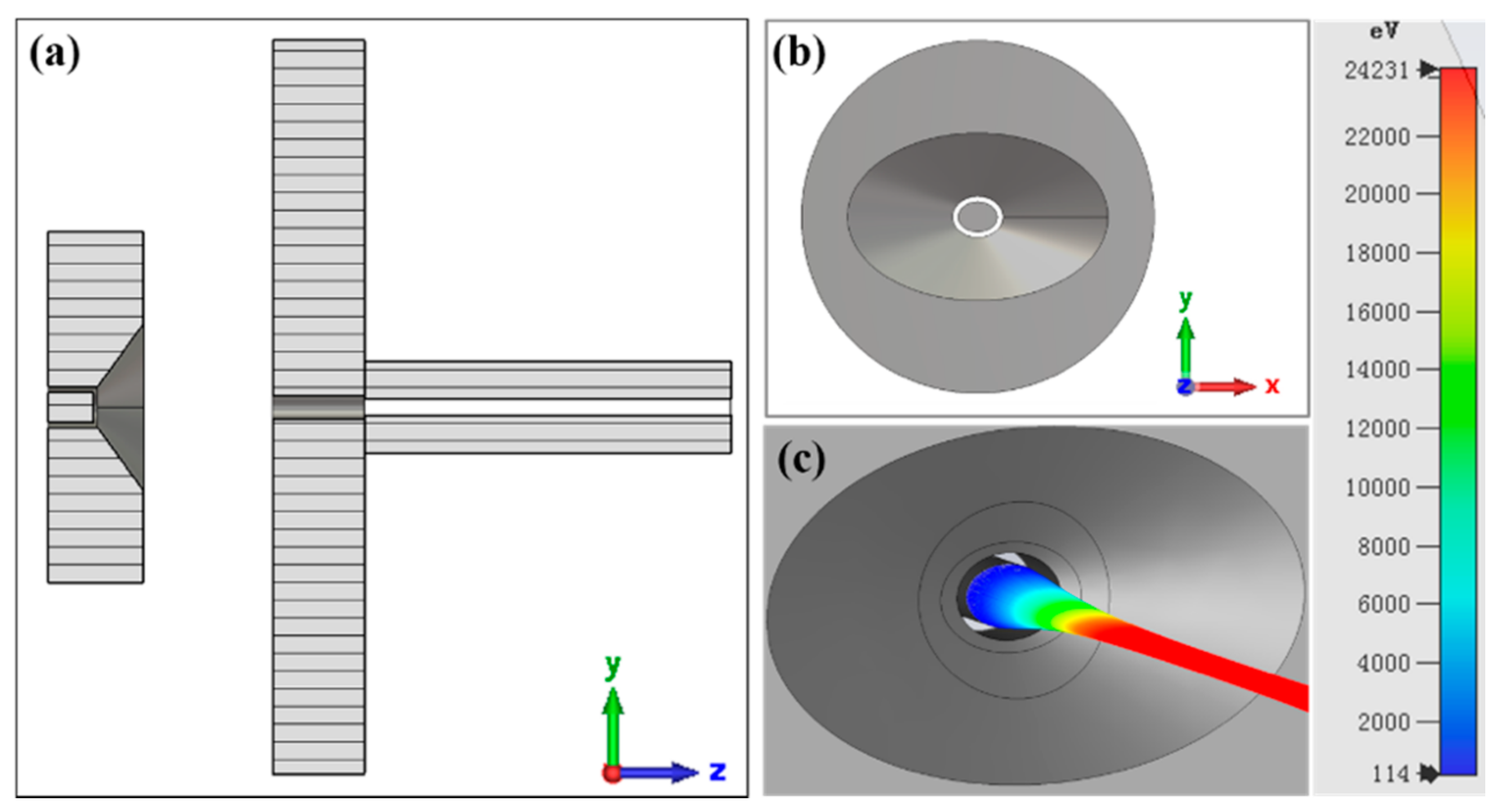
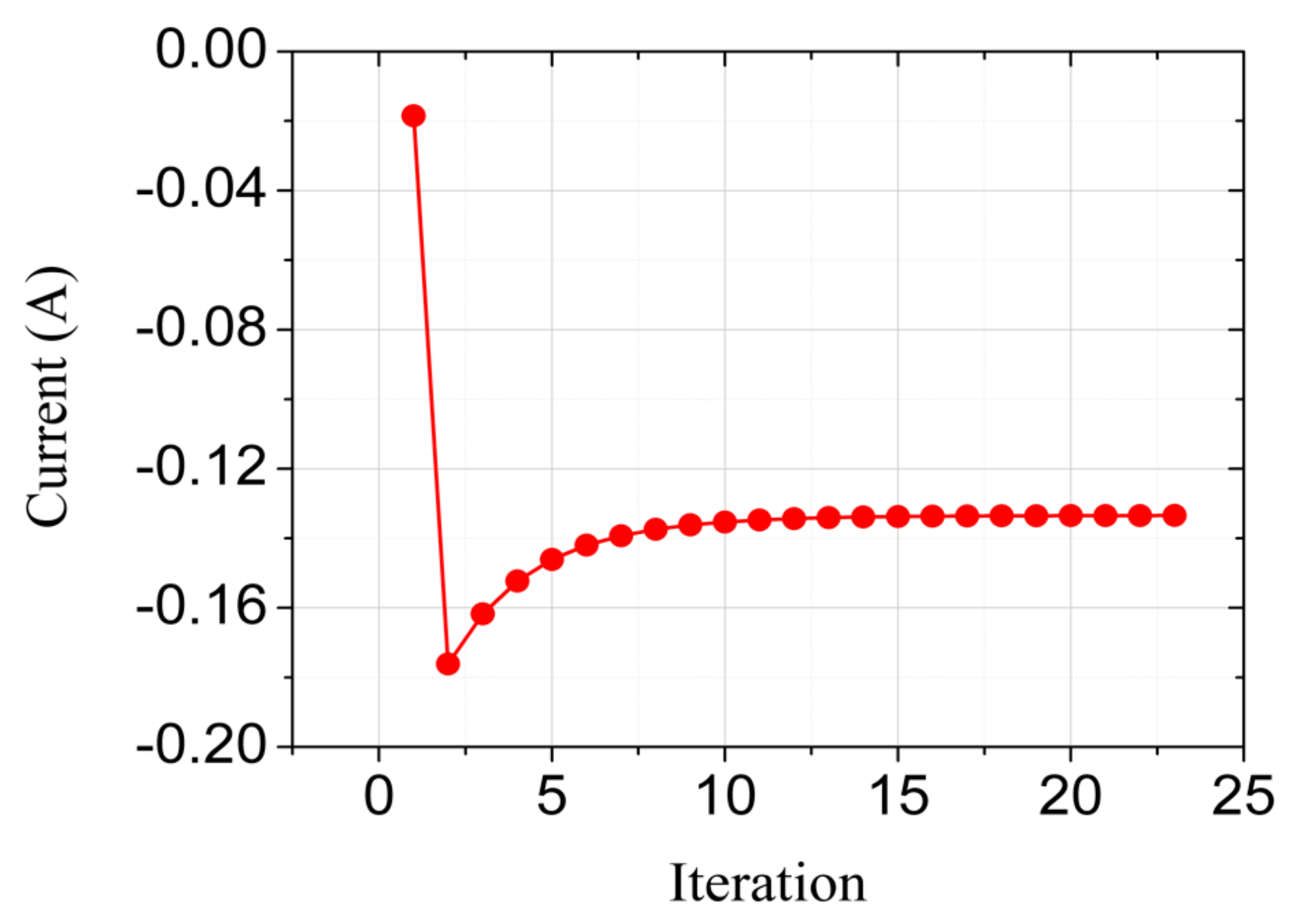

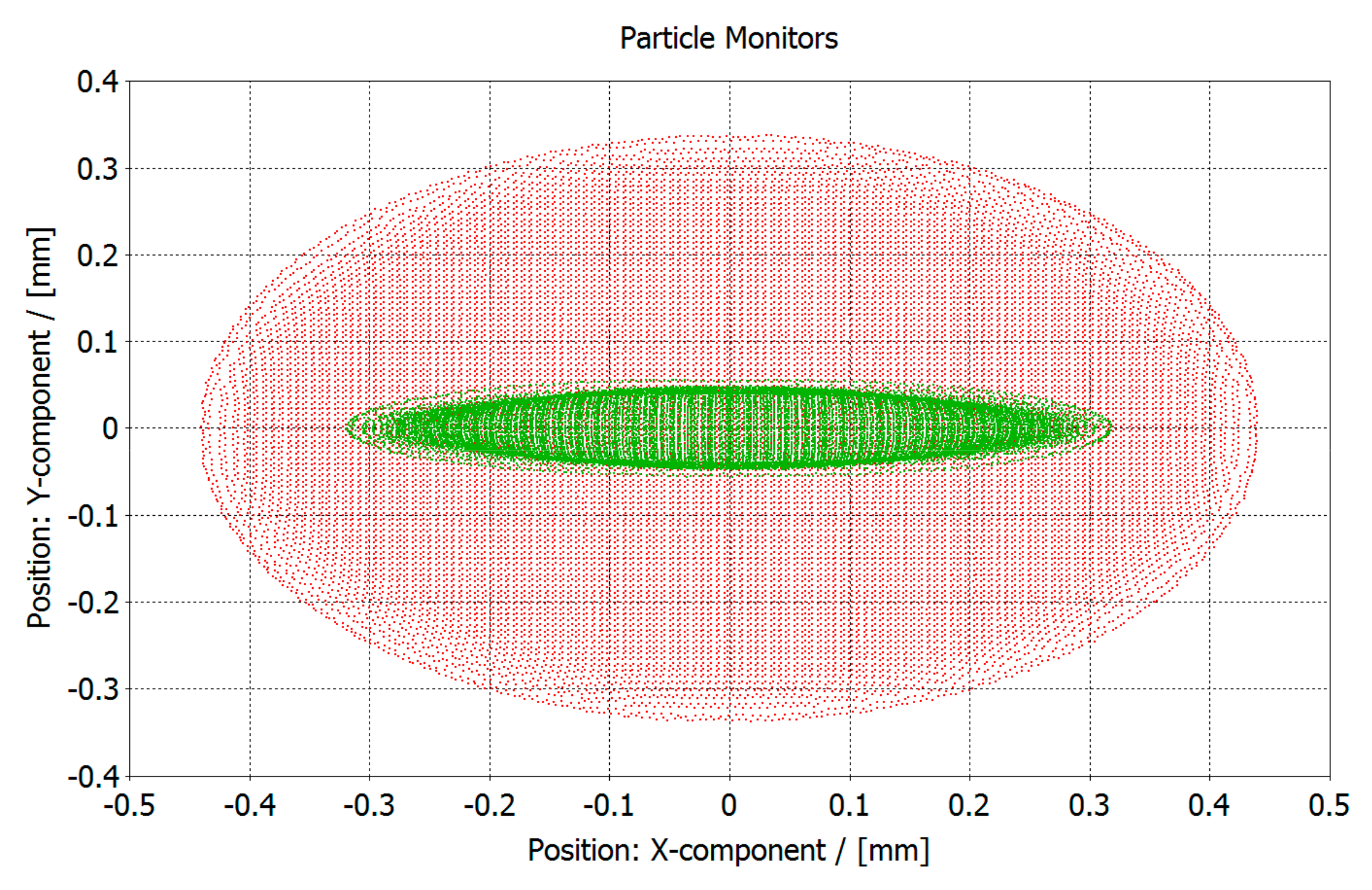
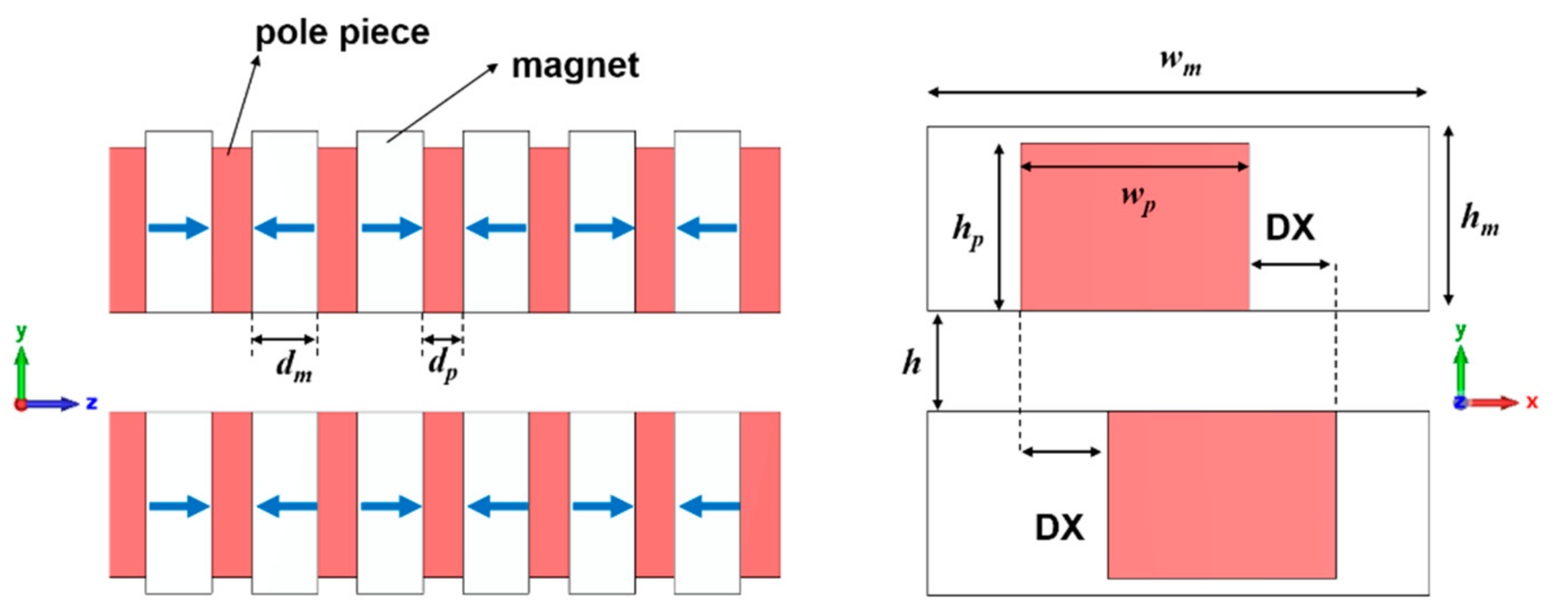
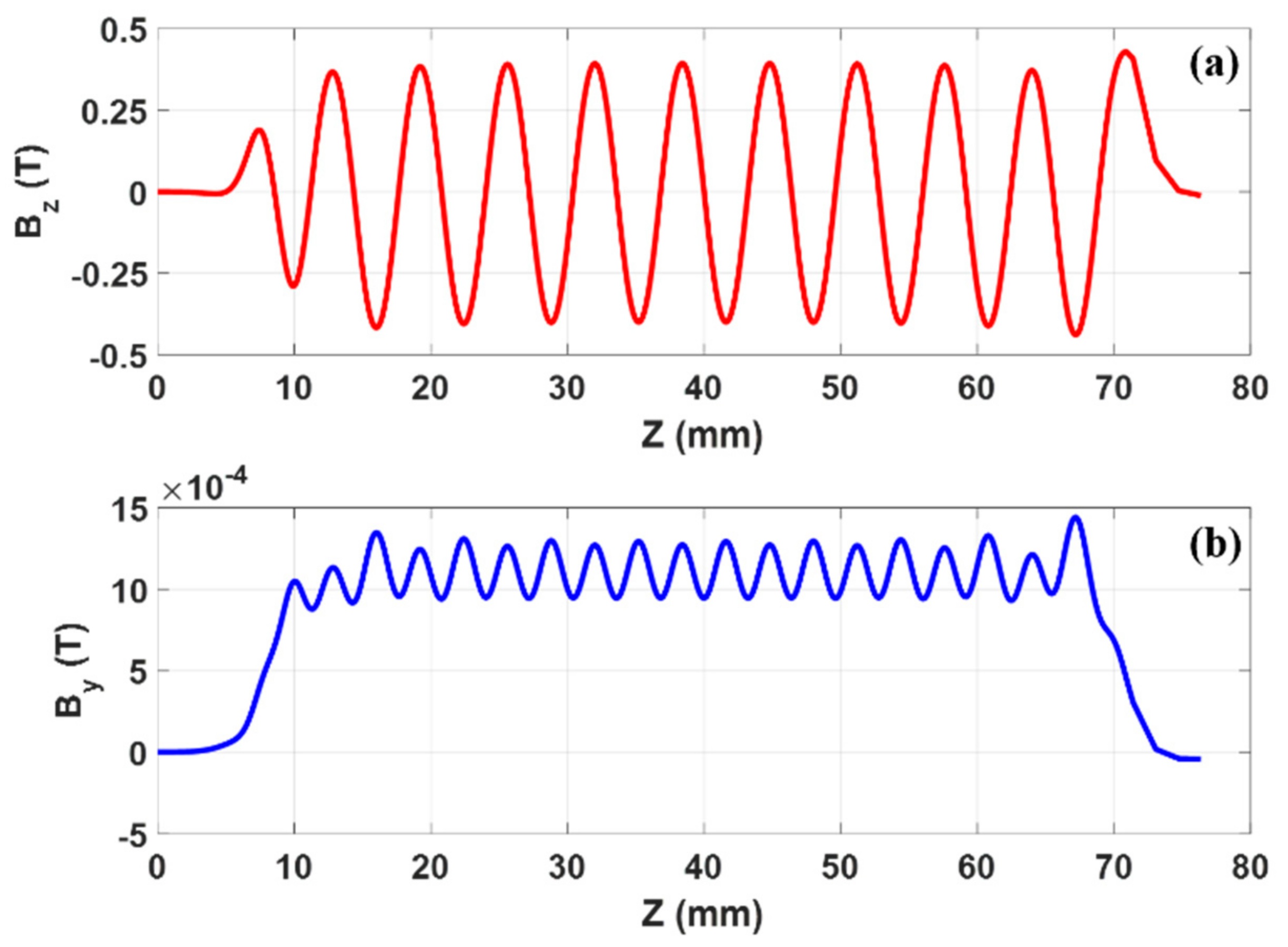
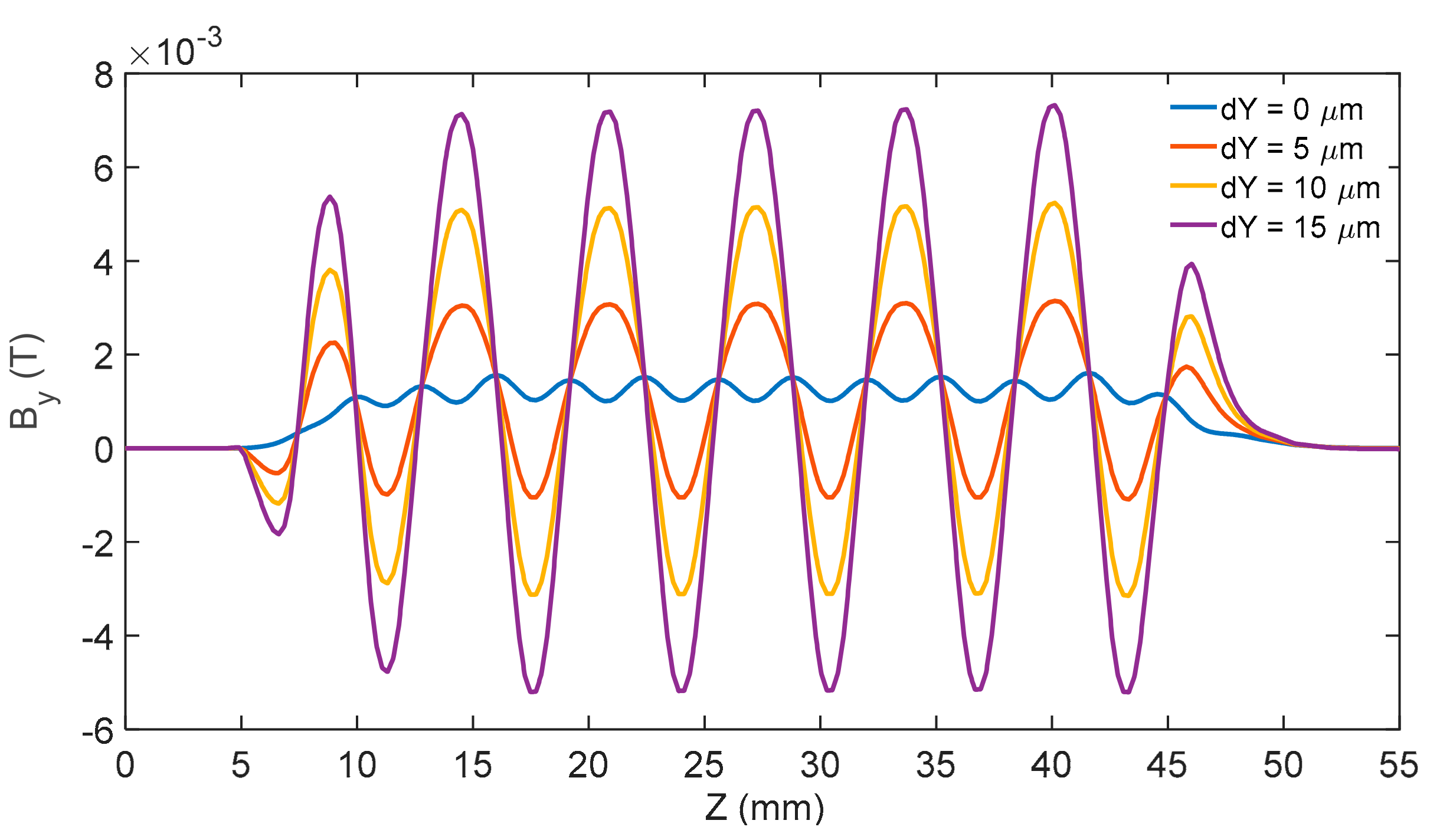
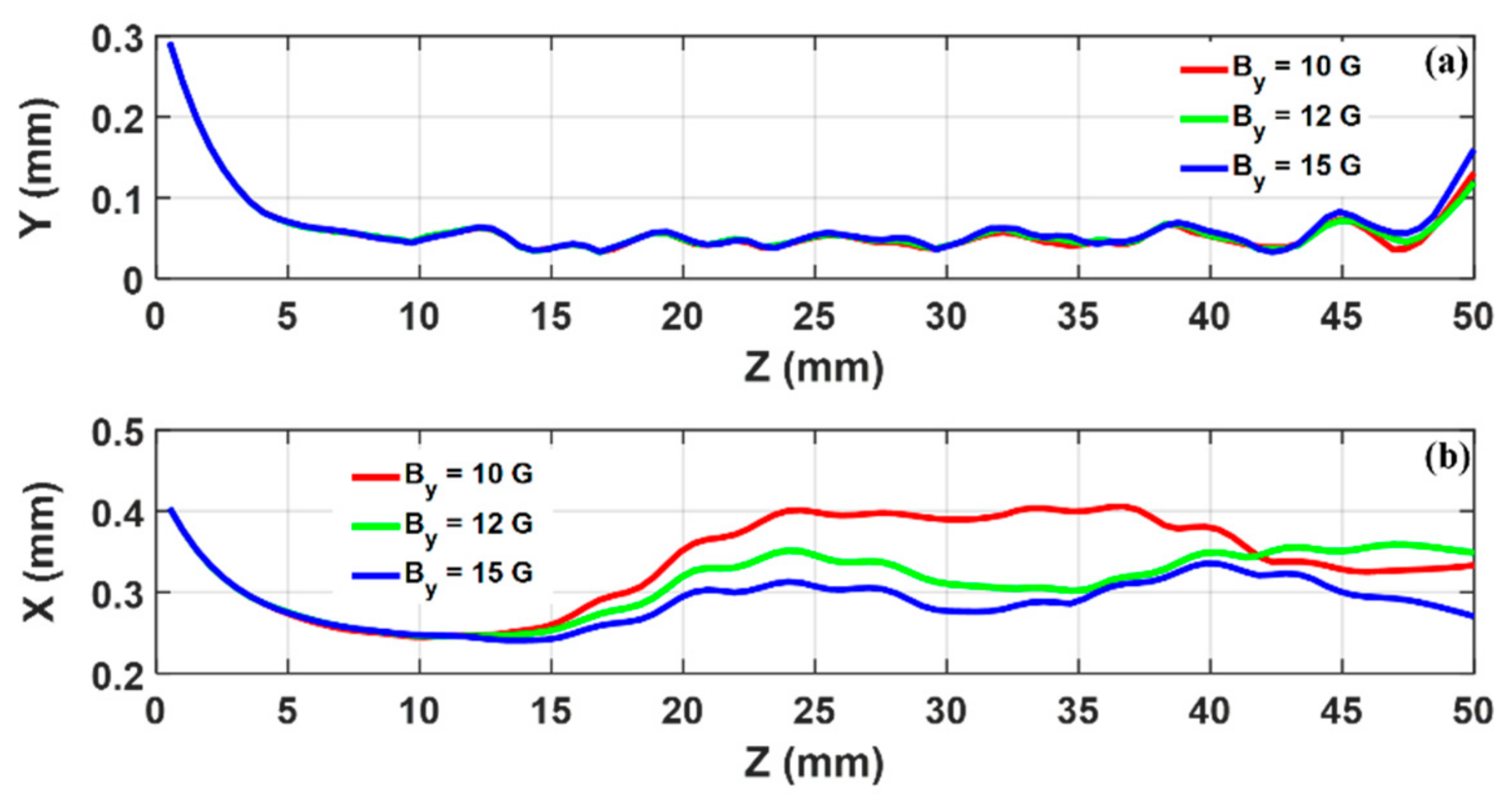
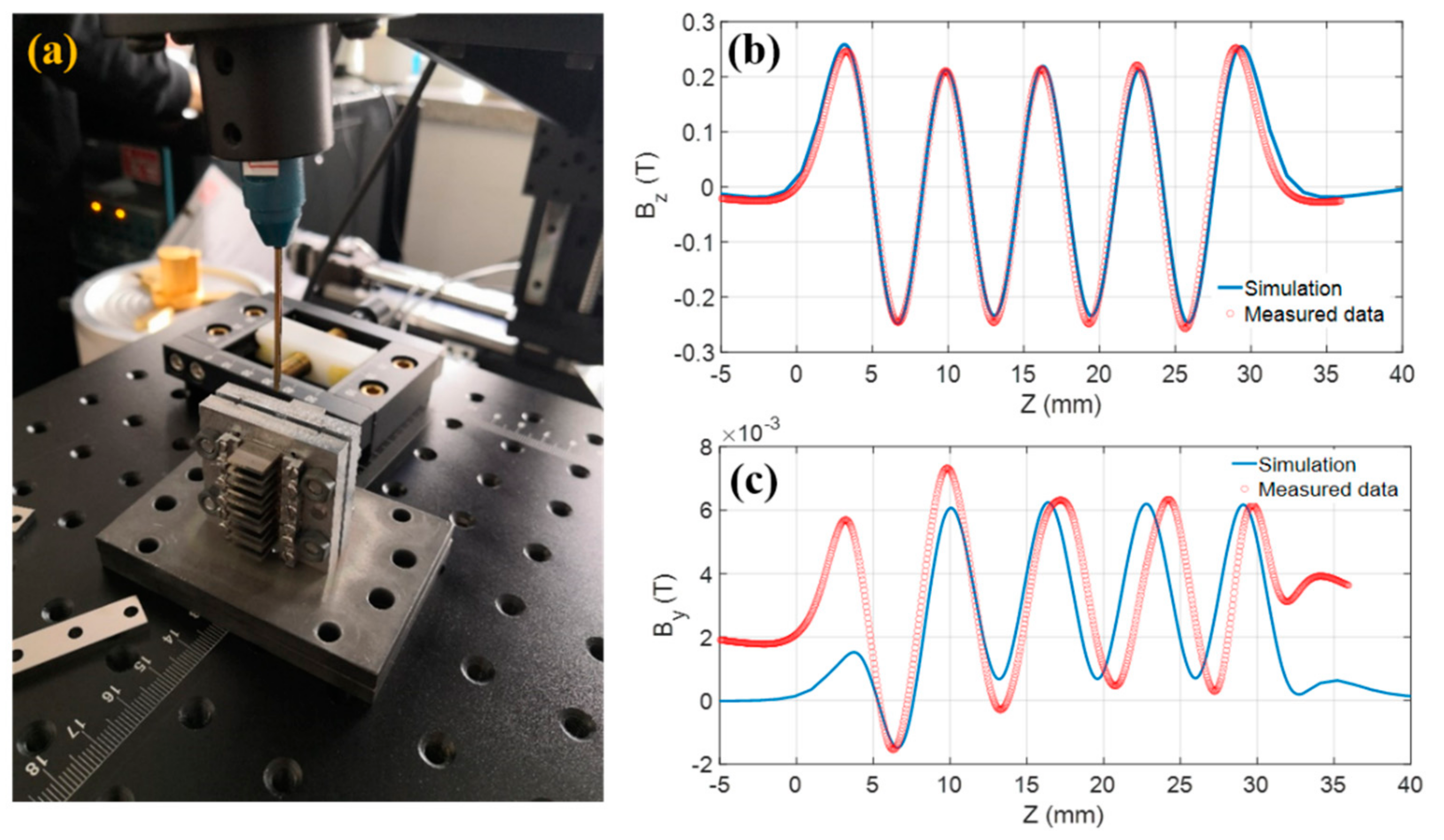




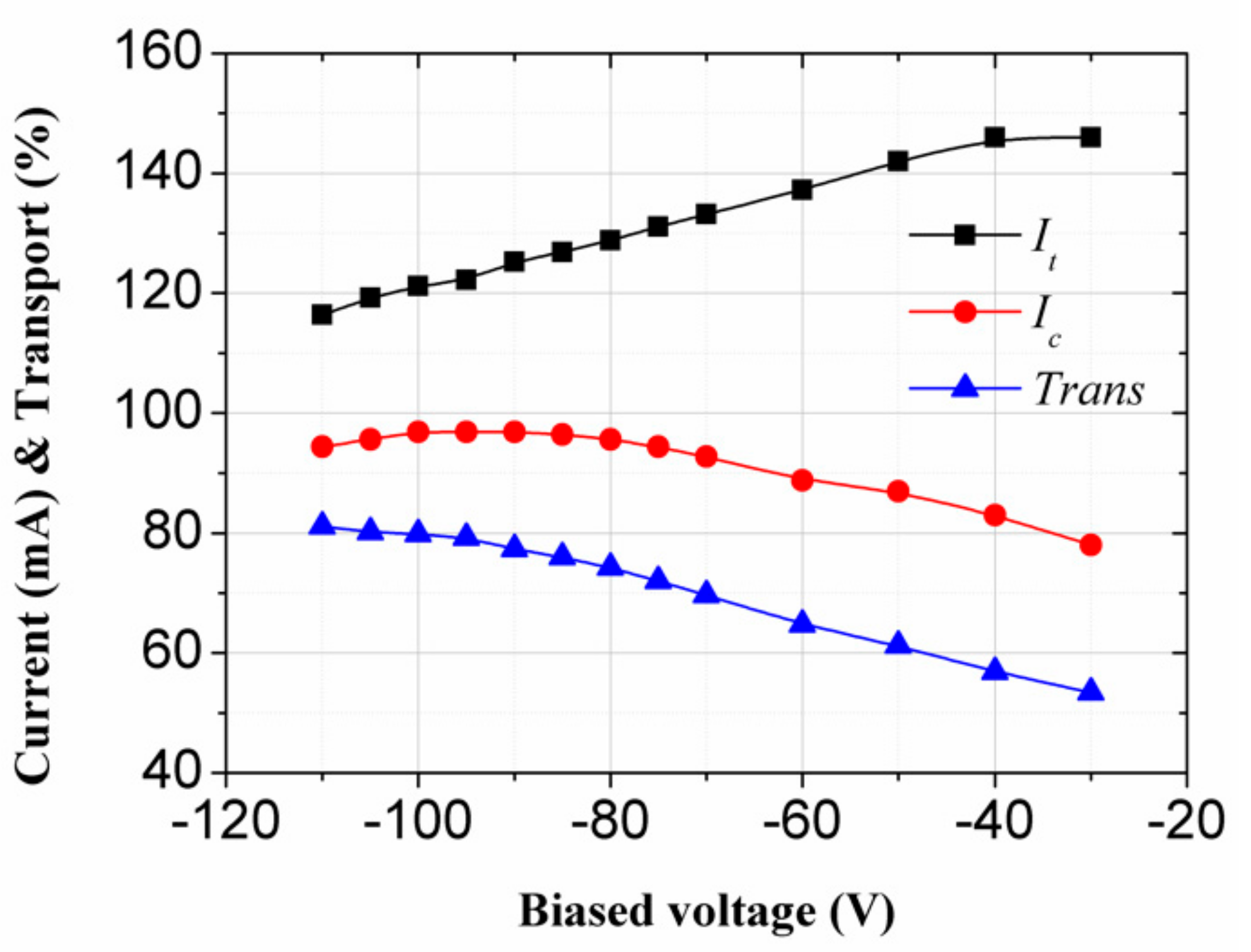
| Parameters | Value (Unit) |
|---|---|
| Cathode voltage V0 | 24.5 kV |
| Emission current I0 | 0.135 A |
| Cathode size | 0.85 × 0.65 mm2 |
| Beam waist size 1 | 0.6 × 0.11 mm2 |
| Tunnel size | 0.8 × 0.2 mm2 |
| Parameters | Value (Unit) |
|---|---|
| Br | 1.09 T |
| Lm | 6.4 mm |
| h | 3.0 mm |
| wm × hm × dm | 15 × 5.5 × 2.0 mm3 |
| wp × hp × dp | 6.8 × 5.0 × 1.2 mm3 |
| Devices | Band | Focusing Scheme | Voltage (kV) | Current (A) | Beam Size and Cathode Size | Cathode Loading (A/cm2) | Current Density (A/cm2) | Normalized Transport Distance | Transport Efficiency (%) |
|---|---|---|---|---|---|---|---|---|---|
| This paper | G | PCM | 24.5 | 0.135 | 0.60 × 0.11 mm2 0.85 × 0.65 mm2 | 31.1 | 285 | 27.5 | 81 |
| TWT [10] | Ka | PCM | 24.3 | 0.8 | 3.2 × 0.6 mm2 3.2 × 1.8 mm2 | 17.68 | 53.05 | 13.16 | 93 |
| TWT [11] | Ka | PCM | 30.9 | 0.82 | 4.0 × 0.4 mm2 1 10:1 | 6.366 | 63.66 | 17 | 97 |
| TWT [14] | Ku | PCM | 34 | 4 | 8.0 × 0.9 mm2 10:1 | 7.073 | 70.73 | 14 | 81 |
| TWT [14] | Q | PCM | 30 | 1.2 | 3.0 × 0.4 mm2 10:1 | 12.73 | 127.3 | 17 | 92 |
| Beamstick [3,5,8] | W/Ka | Solenoid 2 | 20 | 4 | 4 × 0.25 mm2 4 × 10 mm2 | 10 | 400 | 6.27 | 98.5 |
| TWT [4] | G | Solenoid | 22.88 | 0.23 | 0.7 × 0.1 mm2 0.86 × 1.06 mm2 | 38 | 438 | 29.35 | 78.3 |
Publisher’s Note: MDPI stays neutral with regard to jurisdictional claims in published maps and institutional affiliations. |
© 2021 by the authors. Licensee MDPI, Basel, Switzerland. This article is an open access article distributed under the terms and conditions of the Creative Commons Attribution (CC BY) license (https://creativecommons.org/licenses/by/4.0/).
Share and Cite
Zhang, C.; Pan, P.; Chen, X.; Su, S.; Song, B.; Li, Y.; Lü, S.; Cai, J.; Gong, Y.; Feng, J. Design and Experiments of the Sheet Electron Beam Transport with Periodic Cusped Magnetic Focusing for Terahertz Traveling-Wave Tubes. Electronics 2021, 10, 3051. https://doi.org/10.3390/electronics10243051
Zhang C, Pan P, Chen X, Su S, Song B, Li Y, Lü S, Cai J, Gong Y, Feng J. Design and Experiments of the Sheet Electron Beam Transport with Periodic Cusped Magnetic Focusing for Terahertz Traveling-Wave Tubes. Electronics. 2021; 10(24):3051. https://doi.org/10.3390/electronics10243051
Chicago/Turabian StyleZhang, Changqing, Pan Pan, Xueliang Chen, Siming Su, Bowen Song, Ying Li, Suye Lü, Jun Cai, Yubin Gong, and Jinjun Feng. 2021. "Design and Experiments of the Sheet Electron Beam Transport with Periodic Cusped Magnetic Focusing for Terahertz Traveling-Wave Tubes" Electronics 10, no. 24: 3051. https://doi.org/10.3390/electronics10243051






